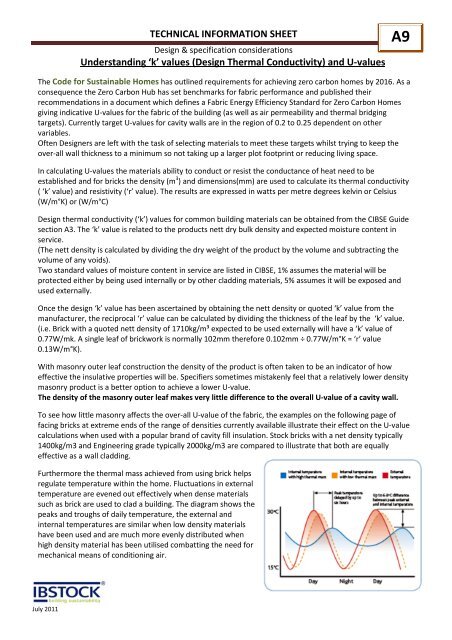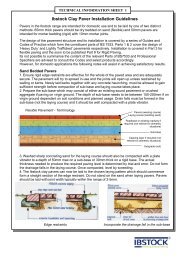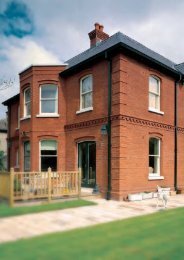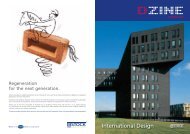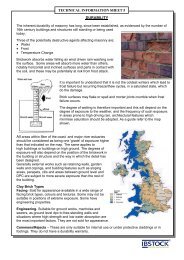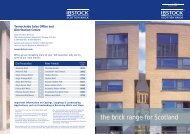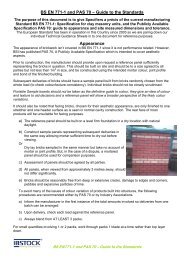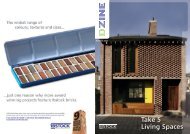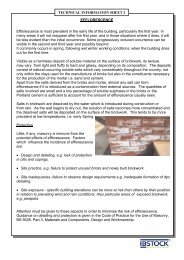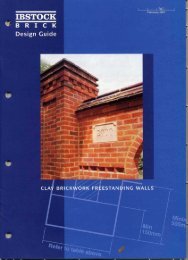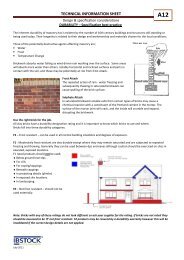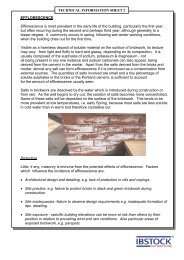(Design Thermal Conductivity) and U-values - Ibstock
(Design Thermal Conductivity) and U-values - Ibstock
(Design Thermal Conductivity) and U-values - Ibstock
Create successful ePaper yourself
Turn your PDF publications into a flip-book with our unique Google optimized e-Paper software.
TECHNICAL INFORMATION SHEET<br />
<strong>Design</strong> & specification considerations<br />
Underst<strong>and</strong>ing ‘k’ <strong>values</strong> (<strong>Design</strong> <strong>Thermal</strong> <strong>Conductivity</strong>) <strong>and</strong> U-<strong>values</strong><br />
A9<br />
The Code for Sustainable Homes has outlined requirements for achieving zero carbon homes by 2016. As a<br />
consequence the Zero Carbon Hub has set benchmarks for fabric performance <strong>and</strong> published their<br />
recommendations in a document which defines a Fabric Energy Efficiency St<strong>and</strong>ard for Zero Carbon Homes<br />
giving indicative U-<strong>values</strong> for the fabric of the building (as well as air permeability <strong>and</strong> thermal bridging<br />
targets). Currently target U-<strong>values</strong> for cavity walls are in the region of 0.2 to 0.25 dependent on other<br />
variables.<br />
Often <strong>Design</strong>ers are left with the task of selecting materials to meet these targets whilst trying to keep the<br />
over-all wall thickness to a minimum so not taking up a larger plot footprint or reducing living space.<br />
In calculating U-<strong>values</strong> the materials ability to conduct or resist the conductance of heat need to be<br />
established <strong>and</strong> for bricks the density (m 3 ) <strong>and</strong> dimensions(mm) are used to calculate its thermal conductivity<br />
( ‘k’ value) <strong>and</strong> resistivity (‘r’ value). The results are expressed in watts per metre degrees kelvin or Celsius<br />
(W/m°K) or (W/m°C)<br />
<strong>Design</strong> thermal conductivity (‘k’) <strong>values</strong> for common building materials can be obtained from the CIBSE Guide<br />
section A3. The ‘k’ value is related to the products nett dry bulk density <strong>and</strong> expected moisture content in<br />
service.<br />
(The nett density is calculated by dividing the dry weight of the product by the volume <strong>and</strong> subtracting the<br />
volume of any voids).<br />
Two st<strong>and</strong>ard <strong>values</strong> of moisture content in service are listed in CIBSE, 1% assumes the material will be<br />
protected either by being used internally or by other cladding materials, 5% assumes it will be exposed <strong>and</strong><br />
used externally.<br />
Once the design ‘k’ value has been ascertained by obtaining the nett density or quoted ‘k’ value from the<br />
manufacturer, the reciprocal ‘r’ value can be calculated by dividing the thickness of the leaf by the ‘k’ value.<br />
(i.e. Brick with a quoted nett density of 1710kg/m³ expected to be used externally will have a ‘k’ value of<br />
0.77W/mk. A single leaf of brickwork is normally 102mm therefore 0.102mm ÷ 0.77W/m°K = ‘r’ value<br />
0.13W/m°K).<br />
With masonry outer leaf construction the density of the product is often taken to be an indicator of how<br />
effective the insulative properties will be. Specifiers sometimes mistakenly feel that a relatively lower density<br />
masonry product is a better option to achieve a lower U-value.<br />
The density of the masonry outer leaf makes very little difference to the overall U-value of a cavity wall.<br />
To see how little masonry affects the over-all U-value of the fabric, the examples on the following page of<br />
facing bricks at extreme ends of the range of densities currently available illustrate their effect on the U-value<br />
calculations when used with a popular br<strong>and</strong> of cavity fill insulation. Stock bricks with a net density typically<br />
1400kg/m3 <strong>and</strong> Engineering grade typically 2000kg/m3 are compared to illustrate that both are equally<br />
effective as a wall cladding.<br />
Furthermore the thermal mass achieved from using brick helps<br />
regulate temperature within the home. Fluctuations in external<br />
temperature are evened out effectively when dense materials<br />
such as brick are used to clad a building. The diagram shows the<br />
peaks <strong>and</strong> troughs of daily temperature, the external <strong>and</strong><br />
internal temperatures are similar when low density materials<br />
have been used <strong>and</strong> are much more evenly distributed when<br />
high density material has been utilised combatting the need for<br />
mechanical means of conditioning air.<br />
July 2011
TECHNICAL INFORMATION SHEET<br />
<strong>Design</strong> & specification considerations<br />
A9<br />
Page 2<br />
U-value calculations using bricks of different density.<br />
Brick nett density 1400kg/m 3<br />
Thickness<br />
mm<br />
Converted to<br />
metres<br />
‘k’<br />
value<br />
resistivity ‘r’<br />
value<br />
Outer surface – from CIBSE - - - - 0.020<br />
Outer leaf – assume brick density of 1400kg/m3 102 0.102 0.60 0.169<br />
Cavity 5 0.005 - - 0.109<br />
Insulation material 95 0.095 0.021 4.520<br />
Inner leaf – aerated block density 600kg/m3 100 0.100 0.19 0.526<br />
Plasterboard – from CIBSE 13 0.013 0.16 0.080<br />
Inner surface – from CIBSE - - - - 0.130<br />
total 5.554<br />
÷ 1 0.180<br />
U-value 0.18<br />
Thickness<br />
mm<br />
Converted to<br />
metres<br />
‘k’<br />
value<br />
resistivity ‘r’<br />
value<br />
Outer surface – from CIBSE - - - - 0.020<br />
Outer leaf – assume brick density of 2000kg/m3 102 0.102 0.96 0.106<br />
Cavity 5 0.005 - - 0.109<br />
Insulation material 95 0.095 0.021 4.520<br />
Inner leaf – aerated block density 600kg/m3 100 0.100 0.19 0.526<br />
Plasterboard – from CIBSE 13 0.013 0.16 0.080<br />
Inner surface – from CIBSE - - - - 0.130<br />
total 5.491<br />
÷ 1 0.182<br />
U-value 0.18<br />
For further information or advice regarding this topic please contact <strong>Ibstock</strong>’s <strong>Design</strong> & Technical Helpline on<br />
0844 800 4576 or email technical@ibstock.co.uk<br />
Although the instructions contained in this publication <strong>and</strong> any other information published by <strong>Ibstock</strong> Brick Ltd are believed to be<br />
accurate at the date of publication, they are strictly for guidance only <strong>and</strong> <strong>Ibstock</strong> Brick Ltd accepts no liability in relation to their use or<br />
for any losses, howsoever caused. You are responsible for taking all reasonable steps to ensure your use of the product conforms to all<br />
applicable health <strong>and</strong> safety requirements from time to time. If in doubt, please consult appropriately qualified persons. All products sold<br />
by <strong>Ibstock</strong> are sold subject to <strong>Ibstock</strong>’s Terms <strong>and</strong> Conditions of Sale, a copy of which is available on request.<br />
July 2011


